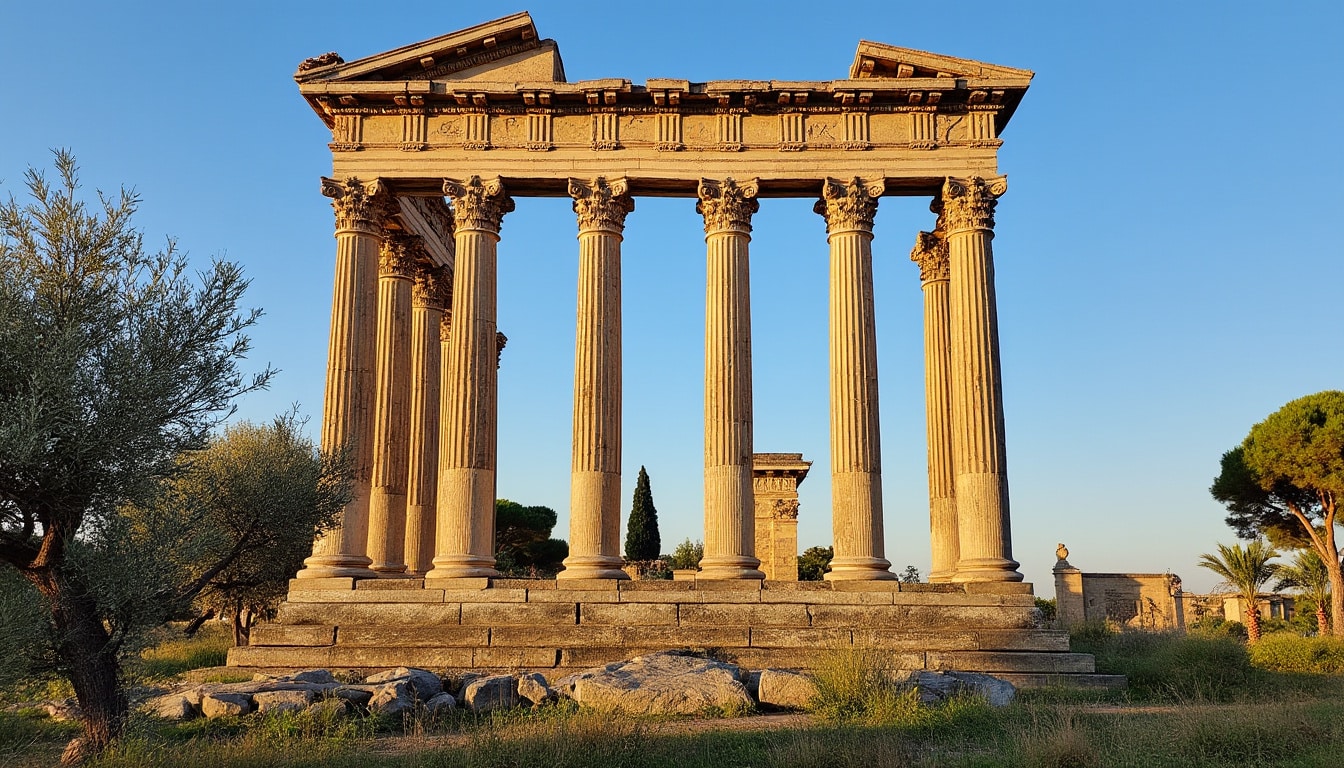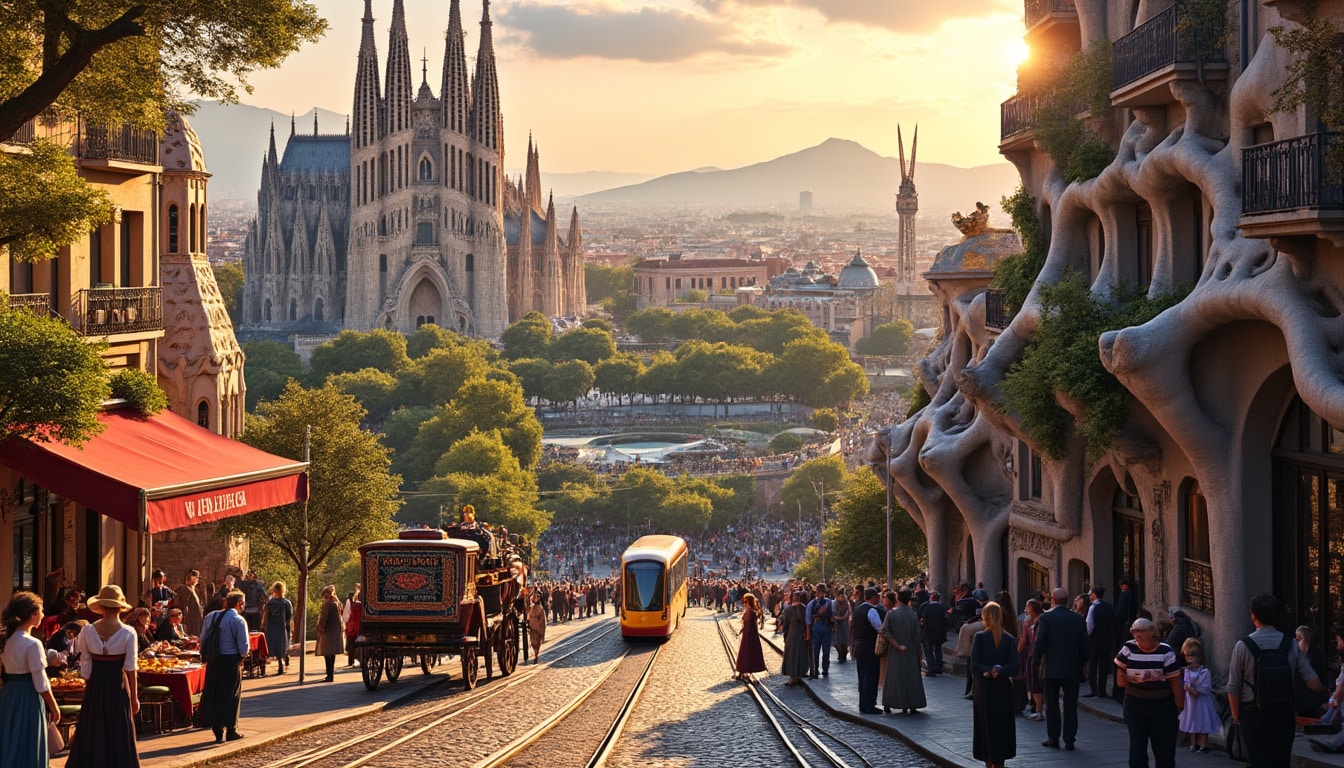Discovering the captivating history of Barcelona involves tracing its remarkable journey from ancient roots to its present-day status as a vibrant and cultural hub. From the early settlements of the Iberians to the impactful presence of the Romans, each era contributed significantly to Barcelona’s architectural marvels, influential culture, and dynamic society. This exploration reveals the layers of history that have shaped Barcelona into a city full of diverse traditions and astounding beauty. Let’s delve into Barcelona’s illustrious past, observing how this city by the sea has evolved over millennia.
The Ancient Foundations of Barcelona: From Phoenicians to Romans
The story of Barcelona begins in the mists of antiquity, with influences from various ancient civilizations that have left lasting impressions on the city. Positioned strategically on the Mediterranean coast, Barcelona’s early history is largely defined by its interactions with the Phoenicians, Carthaginians, and later the Romans.
Initially believed to be founded by either the Phoenicians or Carthaginians, historical consensus now leans towards the Romans establishing Barcelona as Barcino in the late 1st century BC. This small settlement took advantage of its strategic location, nestled between the Besós River to the north and the Llobregat River to the south.
Under Roman rule, Barcino flourished as a prosperous colony complete with a robust infrastructure, including a fortified wall, aqueducts, and an impressive temple. Remnants of these ancient walls still stand proudly in what is now the Gothic Quarter, offering visitors a tangible glimpse into the city’s storied past.
The Roman era was instrumental in setting the groundwork for Barcelona’s urban landscape. Roman Law, culture, and language shaped the future political and social structures of the city, making it a crucial administrative hub. As the heart of Roman Catalunya, Barcelona was a beacon of ancient civilization on the Iberian Peninsula, laying the groundwork for future generations.

As we unearth the city’s Roman roots, it’s clear that the enduring legacies of this era are etched into Barcelona’s very foundation. Whether you’re walking through the narrow, winding streets of the Gothic Quarter or admiring the detailed mosaics found in local museums, the ancient world of Barcino remains a cherished chapter in Barcelona’s lively history.
As you venture through the city’s antiquities, remember that beneath every stone lies a story of ancient ambition, shaping a cultural tapestry that continues to inspire and enchant in our modern age🌟.
Gothic Marvels: Medieval Barcelona and Its Architectural Renaissance
The medieval period ushered in a time of significant transformation and growth for Barcelona, marked by architectural advancements and a burgeoning trade network. During this era, Gothic architecture emerged, leaving an indelible mark on the city’s character. The prestigious Barcelona Cathedral, a stunning example of Gothic ingenuity, stands as a testament to the creative spirit of the time.
This era saw the construction of many of Barcelona’s iconic structures, including the majestic Palace of the Generalitat and various religious edifices. The dynamic Gothic Quarter, with its narrow alleys and vibrant plazas, became the epicenter of political, social, and religious life.
The economic prosperity of medieval Barcelona can be attributed to its strategic location as a Mediterranean trading power. This prosperity encouraged the development of innovative architectural designs, and thus arose the famous Consell de Cent, an early municipal council composed of influential citizens whose decisions would shape the cultural and political landscape of the city.
Throughout the 13th and 14th centuries, Barcelona expanded its influence across the Mediterranean, reaching as far as Sicily, Sardinia, and Corsica. This expansion not only strengthened its economic status but also enriched its cultural tapestry with newfound artistic and scientific knowledge, fostering an environment where arts and scholarly pursuits thrived.
Indeed, the artistic and architectural innovations of this period laid crucial groundwork for future movements. The elegant archways and elaborate facades of the Gothic Quarter capture the essence of an era that celebrated creativity and intellectual exploration, ultimately elevating Barcelona to a prominent role in European history.
Through the careful preservation of these medieval marvels, modern visitors and locals alike can appreciate the enduring charm of Gothic architecture. Every cobblestone street and towering spire narrates a captivating story of medieval ambition and artistic brilliance, bridging the past and present in the most splendid fashion📜.
The Rise and Fall: Political and Economic Turbulence in the Early Modern Era
As we journey further into Barcelona’s history, the early modern era emerges as a tumultuous yet transformative period. Between the 15th and 17th centuries, Barcelona experienced significant political shifts and economic challenges that shaped its future direction.
One of the pivotal moments was the marriage of Ferdinand of Aragon and Isabella of Castille, which united various Spanish territories, forming the foundation for the current Spanish state. Barcelona, once central to regional rulership, found its influence waning as the national focus shifted to Madrid. Nevertheless, the city maintained a distinct identity, rooted in its unique Catalan culture.
Economic fluctuations dominated the narrative as well. The introduction of new trade routes between the Americas and Europe invigorated some sectors, yet the traditional industries struggled to compete. These economic disparities often led to social unrest and political disputes, including the infamous Catalan Revolt against the Spanish monarchy in the mid-17th century.
This period was not without cultural advancements. Despite economic challenges, Barcelona’s commitment to preserving its Catalan heritage and fostering intellectual innovation endured. The foundation of European maritime law, known as Llibre del Consolat del Mar, is one such example of enduring intellectual enterprise.
Amidst political turbulence, Barcelona continued to be a crucial cultural center. Its rich heritage was further nurtured through initiatives like the establishment of a municipal council, the Generalitat, which demonstrated a dedication to local governance and citizen representation.
The early modern era’s legacy is one of resilience and renewal. The city’s ability to withstand and adapt to economic uncertainties and political upheaval exemplifies a spirit of perseverance that continues to define Barcelona today. By examining this era, we gain insight into how Barcelona’s quest for identity and autonomy has navigated the waves of change, setting the stage for its modern evolution⚓.
Modernism and Beyond: Barcelona’s Cultural and Architectural Renaissance
As the 19th century drew to a close, Barcelona embraced an era of extraordinary artistic innovation that would forever alter its skyline. This period, known as the Catalan Modernism movement, introduced groundbreaking architects like Antoni Gaudí, whose visionary works have become synonymous with Barcelona’s identity.
Amidst the city’s vibrant streets, Gaudí left an indelible mark with iconic masterpieces such as La Sagrada Familia, Casa Batlló, and Parc Güell. These architectural wonders did more than embellish the cityscape; they revolutionized architectural thought and design, intertwining organic forms with vibrant color palettes and intricate detail.
Another crucial contributor to this movement was Lluís Domènech i Montaner, whose contributions like the Palau de la Música Catalana and Hospital de Sant Pau exemplify the intricate and imaginative nature of Catalan Modernism. These structures combined practicality with artistic expression, pushing the boundaries of conventional architecture.
The cultural renaissance transcended architecture to include a rich tapestry of arts, embracing the works of genius artists like Pablo Picasso and Joan Miró. The Pablo Picasso Museum and Miró Foundation house extensive collections that celebrate these artists’ contributions and influence on modern art.
- 🎨 Antoni Gaudí: La Sagrada Familia, Casa Batlló, Parc Güell
- 🎭 Pablo Picasso: Picasso Museum
- 🎨 Joan Miró: Miró Foundation
- 🏛️ Lluís Domènech i Montaner: Palau de la Música
This cultural explosion was paralleled by significant urban renewal initiatives. The extension of the L’Eixample district, featuring geometric blocks allowing for open spaces and greenery, was a response to the city’s burgeoning population and industrial growth. Barcelona’s architectural landscape became a harmonious blend of tradition and modernity.
Today, as we stroll through the streets of Barcelona, the legacy of modernism stands distinct and inspiring. It’s a journey through time, where each ornate facade and artistic endeavor speaks to a period of historical richness and cultural triumph. As we marvel at these treasures, Barcelona’s commitment to artistic passion and cultural progress remains as vibrant as ever🌻.
Barcelona in the 20th and 21st Centuries: Progression and Innovation
The 20th and 21st centuries have seen Barcelona transform into a vital hub of technological innovation and cultural distinction. Following periods of reforms and industrial growth, Barcelona hosted the prestigious 1992 Olympic Games, which heralded a new era of urban regeneration and global prominence.
The Olympics spurred extensive renovations across the city, resulting in a rejuvenated waterfront, modernized infrastructure, and improved public transportation systems. This transformation fostered a sense of unity and pride among the city’s inhabitants, aligning with FC Barcelona’s motto, “More than a club”, echoing Barcelona’s ethos of community and belonging.
With projects like the expansion of the iconic Camp Nou and the opening of cultural venues such as the Museu d’Historia de Barcelona, the city has successfully blended advances in technology with a commitment to preserving its rich history and culture.
In recent years, Barcelona has embraced sustainability and smart city initiatives, aiming to reduce environmental impact while enhancing the quality of life for its residents. This commitment to innovation is symbolized by projects like the superblocks, designed to decrease traffic, promote pedestrian zones, and encourage alternative transportation methods.
Barcelona’s robust cultural calendar, featuring events such as the Primavera Sound Festival and the Barcelona Design Week, further cements its reputation as a leading cultural destination. Additionally, its rich tapestry of traditions, ranging from exquisite Catalan cuisine to innovative contemporary art, continues to captivate both residents and visitors.
- 🏟️ Key Sporting Events: 1992 Olympics
- 🏡 Urban Innovations: Superblocks, Sustainable Projects
- 🎉 Cultural Events: Primavera Sound Festival, Barcelona Design Week
The advent of technological progress, coupled with Barcelona’s renowned artistic and cultural legacies, ensures a forward-thinking environment that honors the past while looking confidently toward the future. It is this meticulous balance of heritage, innovation, and creativity that continues to propel Barcelona onto the global stage🗺️.
Frequently Asked Questions
What are some of the must-see historical sites in Barcelona?
Key historical sites include the Barcelona Cathedral, the ancient Roman walls in the Gothic Quarter, La Sagrada Familia, and the Pablo Picasso Museum. Each offers unique insights into different eras of Barcelona’s rich history.
How did the 1992 Olympics impact Barcelona?
The 1992 Olympics brought a wave of urban redevelopment, enhancing transportation, infrastructure, and the overall quality of life in the city. It also positioned Barcelona as a top global tourist destination.
What is the significance of Antoni Gaudí’s work in Barcelona?
Antoni Gaudí’s work, including iconic structures like La Sagrada Familia and Casa Batlló, is celebrated for its innovative use of geometry, color, and organic forms, making Barcelona a global hub for architectural enthusiasts.

